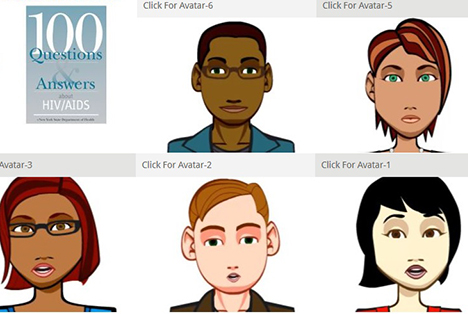By Jill Pease

How soon after exposure can HIV infection be detected? When does a person with HIV infection have AIDS? How long can people live with HIV or AIDS? These and 97 other questions are answered by eight avatars in the University of Florida’s new web-based HIV/AIDS Avatar Project.
Created by a team at UF’s Rural South Public Health Training Center, the avatar project is designed to provide relevant and factual information for patients, and serve as a tool for public health workers.
“We hope this becomes an important resource for public health workers by providing them with the newest and most accurate information on HIV/AIDS and the best way to present it to their patients. Local health departments can also refer patients to the avatar project website, particularly people in rural areas who may have less access to health care than those in urban settings,” said Mark Hart, Ed.D., the director of the Rural South Public Health Training Center and a research assistant scientist in the UF College of Public Health and Health Professions’ department of behavioral science and community health.
The HIV/AIDS Avatar Project was borne out of the desire of a local county health department to provide staff members with information on how to properly answer their clients’ questions about HIV/AIDS, and to be a resource for patients who don’t know how to ask a particular question about the disease, or even know what questions to ask. The Rural South Public Health Training Center partnered with the New York State Department of Health to use content from their publication “100 Questions & Answers about HIV/AIDS.” The center team then created both male and female avatars representing four ethnicities to provide recorded responses to each of the 100 questions. Previous research has demonstrated that people may be more apt to ask a sensitive question to an avatar than they are to a person.
While several studies have examined self-identity and avatars in video games, little research exists on how users select an avatar’s gender and ethnicity when interacting with them in medical settings, Hart said. Center researchers will ask HIV/AIDS Avatar Project users to participate in a short survey that asks their age, gender and ethnicity in order to determine if users prefer avatars that are similar to their own gender and ethnicity.
“As avatars are used more and more to convey health information, we want to determine if people will use avatars more frequently if there is one that closely matches themselves,” Hart said.
The HIV/AIDS Avatar Project is available at hiv-avatar-project.com, or on YouTube.
The avatar project is one of three center programs supported by a new $99,346 grant from the Health Resources and Services Administration of the U.S. Department of Health and Human Services. The funds will allow the center to increase its online continuing education offerings, including new courses on the Affordable Care Act, adolescent pregnancy and trends in drug and tobacco use. Now in its fourth year, the Rural South Public Health Training Center has provided free continuing education training to more than 3,000 public health workers.
In addition, the center will complete the final three counties in its health needs assessment of Florida’s 15 medically underserved counties. Center staff members have conducted thousands of interviews with county residents at health departments and in the community.
“We ask questions like: What do you think are the biggest health problems in your county? Do you have health insurance? Where do you go when you’re sick? What’s blocking you from getting health care?” Hart said. “We are giving the citizens a voice to tell us the biggest health issues in their communities.”

